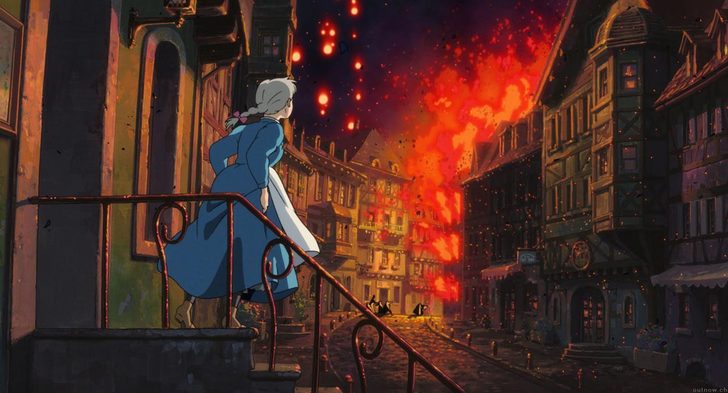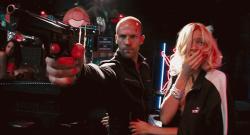 There’s a jarring, hallucinatory effect to the sudden appearance, midway through Hayao Miyazaki’s latest animated fantasy, of vivid images of war. Airborne battlecraft fly low over thickly populated villages, trailing streams of bombs behind them as they move deliberately through the air. Fiery red explosions dot the cityscape below. The imagery is fantastic and chilly, evoking simultaneously the firebombing of European cities during World War II and the surreal television footage of bombs exploding over Baghdad captured during the first Gulf War. But the most obvious referent is the current war in Iraq, where ancient cities have been decimated by heavy explosives and civilian casualties are staggering by nearly any count.
There’s a jarring, hallucinatory effect to the sudden appearance, midway through Hayao Miyazaki’s latest animated fantasy, of vivid images of war. Airborne battlecraft fly low over thickly populated villages, trailing streams of bombs behind them as they move deliberately through the air. Fiery red explosions dot the cityscape below. The imagery is fantastic and chilly, evoking simultaneously the firebombing of European cities during World War II and the surreal television footage of bombs exploding over Baghdad captured during the first Gulf War. But the most obvious referent is the current war in Iraq, where ancient cities have been decimated by heavy explosives and civilian casualties are staggering by nearly any count.
A Miyazaki film, with its languid approach to narrative and fanciful spin on human affairs, might be the last place you’d expect to find political commentary. Miyazaki’s impassioned railing against the fundamental insanity of war is a messy ambition, but it never derails affairs completely. If it complicates and distends the storyline, it also functions as a heartening affirmation of the presence of a striking, fully engaged intelligence behind the images. How could a director with the kitchen-sink sensibilities of Miyazaki credibly claim to impart moral lessons to children without shaking his fist at violence and injustice?
Like the phenomenal Spirited Away, Howl’s Moving Castle is epic in its scope. The opening sequences, which chronicle the rather ordinary life of Sophie, a young woman with the rather mild job description of hat-shop clerk, barely hint at the broad strokes in which the story will be told. Before long, Sophie’s world is populated by an pogoing scarecrow, a fire demon whose energies feed the mechanical walking citadel of the title, and a handsome wizard named Howl, who transforms inexplicably into a bird-soldier who does battle on behalf of unseen masters of war in the skies overhead.
Sophie is also cursed, made to age far beyond her years after she crosses paths with a cranky witch. It’s emblematic of Miyazaki’s thinking that Sophie’s supposed quest to regain her lost youth is one of the last things on her mind. The suddenly elderly woman is almost immediately swept up in a great adventure whose mission is nothing less than saving Howl’s young body and soul — and she’s allowed no time to feel sorry for herself.
Tough love, then, from the heralded master of Japanese animation, whose generosity of spirit is inclusive of the hardships with which he tests and teaches his creations. The narrative style can be baffling to audiences, as witnessed by the poor kid across the aisle from me during my screening who kept crying out to his mother, “Is that a bad guy? Is that a bad guy?” She was providing vague answers. Miyazaki is highly reluctant to make films that dress any characters in good-guy and bad-guy hats. There is much more to most things than can be gleaned by taking a gander at their surface. People change, their hearts are easily broken, and even the worst of them may be deserving of forgiveness. Howl’s Moving Castle terminates abruptly, in a sudden cascade of sweetness and happy endings that’s almost disconcerting given the breadth and depth of feeling evoked during the rest of the film’s running time.
No matter. What’s most affecting about a Miyazaki film is the sheer audacious beauty of the imagery, and on that score Howl’s Moving Castle is no disappointment. On a big screen, the film positively sings with color and light. A scene in which Howl takes Sophie to see a magnificent field of flowers that he remembers from his youth is unexpectedly luminous – it put me in mind of that rainbow ringed field of flowers that always makes audiences gasp at the end of the first segment of Akira Kurosawa’s Dreams. The flip side of that beauty is violence, and scenes depicting war are appropriately grim, the dim red light of fire floating across darkened cityscapes. The technique is impeccable; Studio Ghibli has made notable strides in incorporating CG with traditional animation, with the most obviously computer-generated components of the imagery functioning almost like those sliding paper components in a children’s pop-up book, offering a multifarious complexity to animated dolly shots or the views of the lumbering, insanely complicated assembly that is the castle itself.
The main disappointment in this release is dictated by business concerns. In order to make an animated fantasy marketable to U.S. audiences, who will no doubt be looking to take their children (and in their eagerness to see it as an entertainment geared toward children may underestimate the potential of both Miyazaki and their own offspring), U.S. distributor Disney has — in the same wisdom that leads them to insist on making a Toy Story movie without Pixar — dubbed the film into English for U.S. audiences. That Lauren Bacall and Jean Simmons are quite talented is not the point; that the very Japanese soul of the film seems to die a little death every time Billy Crystal opens his mouth is. Subtitled versions of the film are apparently available; the version I saw on the film’s opening night in New York City was dubbed, and while I’m quite happy to go see the film a second time, it’s a shame that the film has been unnecessarily and garishly tarted up on the occasion of its U.S. release, like a dog made to wear antlers and a goofy sweater at Christmastime.



















Leave a comment